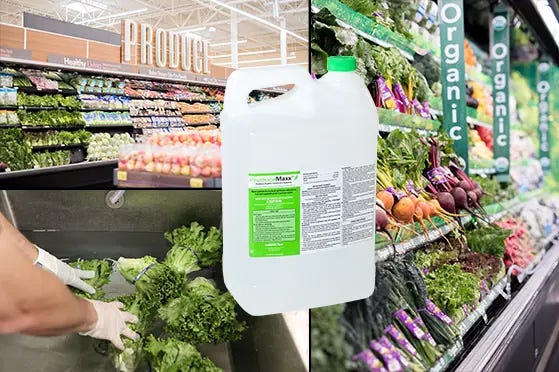The Deceptive Practice of "Crisping"
That's More Than Just Water Being Misted on Grocery Store Produce
In the serene ambiance of a grocery store's produce department, the sight of fresh fruits and vegetables glistening with what appears to be refreshing mist can be enticing. However, what may seem like harmless water is often a deceptive veil masking a concoction known as ProduceMaxx. This antimicrobial cocktail, touted for its ability to enhance the crispness and prolong the freshness of produce, contains chlorine, hydrochlorous acid, and undisclosed "other ingredients". While its application aims to kill bacteria, inhibit mold growth, and maintain the visual appeal of fruits and vegetables, the use of such chemicals raises significant concerns about human health and environmental impact.
The Deception Unveiled: What is ProduceMaxx?
ProduceMaxx, a common product used in grocery stores across the globe, is marketed as a solution to maintain the freshness and appearance of produce. However, beneath its innocuous facade lies a potent blend of chlorine and hydrochlorous acid, along with undisclosed additives. These chemicals serve as powerful antimicrobial agents, effectively sterilizing the surfaces of fruits and vegetables to prevent spoilage and extend shelf life. While consumers may perceive the misting as a harmless practice, the reality is far more insidious.
The Hidden Dangers: Chlorine and Hydrochlorous Acid
Chlorine, a key component of ProduceMaxx, is a well-known disinfectant commonly used in water treatment and sanitation. However, prolonged exposure to chlorine has been linked to adverse health effects, including respiratory irritation, skin irritation, and exacerbation of asthma symptoms. Furthermore, chlorinated compounds have been classified as carcinogenic by leading health organizations, raising serious concerns about the safety of its use on consumable goods.
Hydrochlorous acid, another active ingredient in ProduceMaxx, is lauded for its antimicrobial properties. However, its potential health risks cannot be ignored. Exposure to hydrochlorous acid can lead to irritation of the eyes, skin, and respiratory tract. Moreover, similar to chlorine, there are concerns about its carcinogenic potential, highlighting the need for caution in its application, especially on food items intended for human consumption.
Just read the Safety Data Sheet straight from the company for yourself. Is this something that should be put on our food supply?
Alternative Solutions: A Path Towards Healthier Choices
In light of the deceptive practices employed in grocery store produce departments, consumers are encouraged to explore alternative options that prioritize health and sustainability:
Growing Your Own Food: Consider cultivating your own fruits and vegetables using organic methods free from harmful chemicals. Not only does this ensure the freshness and quality of produce, but it also promotes a deeper connection to the food you consume and reduces reliance on industrial agriculture practices.
Supporting Local Farms: Seek out local farms and farmers' markets that prioritize organic farming practices and eschew the use of chemical pesticides and preservatives. By directly supporting local producers, you not only access fresher and healthier produce but also contribute to the sustainability of your community's food system.
Demanding Transparency: Advocate for greater transparency in food labeling and production practices. Urge grocery stores to disclose the use of chemical treatments such as ProduceMaxx on their produce, empowering consumers to make informed choices about the products they purchase.
Know What You’re Eating
The deceptive practice of "crisping" in grocery store produce departments underscores the need for heightened awareness and scrutiny regarding the chemicals used in food production. By embracing alternative solutions and advocating for transparency and sustainability, consumers can take proactive steps towards a healthier and more environmentally conscious food system.





